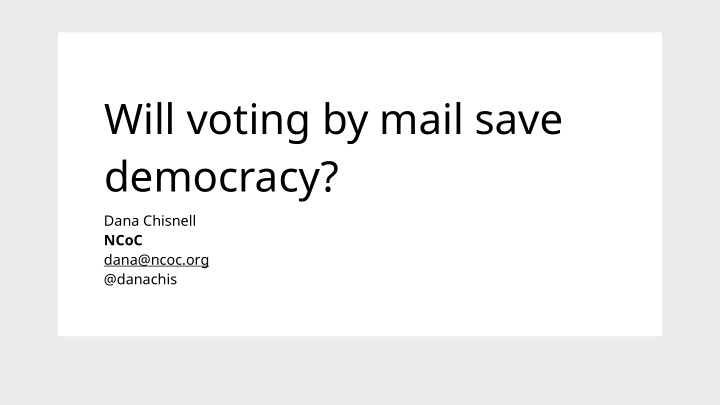



Will voting by mail save democracy? Dana Chisnell NCoC dana@ncoc.org @danachis
Michigan No-excuse absentee voting passed in 2018
Size of change: Flint, Michigan • Flint is one of 25 communities with more than 30,000 residents reporting an increase of MORE THAN 100% in mail ballots issued • From 2016 to 2020, Flint’s mail ballot requests increased for the presidential primary by 854% (Source: MLive.com 28 February 2020) • Statewide, requests were up 70% for the primary
Size of change: Michigan
Downstream administration issues Going from a state with little vote by mail to a lot presents complications • Do you count at precincts or centrally? • When can you start processing ballots (not counting them)? • When can you start counting? • Who does the counting and where does that happen? • How do you ensure that precincts know whether someone has already voted absentee? • What if voters don’t remember that they requested an absentee ballot?
Vote by mail is awesome for many voters • Convenient — the ballot comes to you • No need to take time off or reschedule things around going to the polls • No waiting in lines • Plenty of time to research candidates and issues
It is not free of effort • Mark the ballot Find out about Learn that Find out how Fill out a Wait for your • Put the ballot inside an election you can vote to request a request online ballot to arrive in the secrecy envelope absentee ballot and or on paper the mail • Sign the envelope what the If on paper, put it If the ballot • Put that inside the deadlines in an envelope doesn’t arrive, return envelope are and mail it to the request another • Find appropriate right place with one, go to the postage the right postage polling place, or • Mail it in don’t vote (Or in some cases, drop at a polling place)
Vote-by-mail is not great for all voters • It’s not accessible for many people with disabilities • People who have low literacy and low English proficiency struggle with instructions and affidavits • Challenging for people who are homeless or who have university addresses
For students and others • If someone has requested an absentee ballot but it hasn’t been mailed yet, contact the election office • If you’ve requested an absentee ballot and ballots have been mailed, you’ll probably have to fill out a form saying you didn’t get the old one and you want a new one • If you decide you want to vote “at the polls,” you are likely to have to vote “curbside”
Vote-by-mail landscape
Center for Civic Design civicdesign.org
Flavors of vote-by-mail • All-mail elections Registered voters automatically get a ballot in the mail and return it by mail or drop it in a drop box • Permanent vote-by-mail Registered voters can put in one request to be sent a ballot every election • No-excuse absentee voting Registered voters must apply for a ballot to be sent to them but don’t need a reason • Absentee voting Registered voters must apply for a ballot and give a reason for being absent from the polls, sometimes with backup documentation.
Voting by mail will be a different experience in different parts of the country
There won’t be accurate exit polls, and unofficial results will be slower in coming out
Some votes may be lost because of unreliable service from the U.S. Postal Service
Simple but not easy
Communicating with voters
Answer voters’ questions • Dates and deadlines — be specific • Signatures — present and matching • Rules — who can return your ballot • Tracking — how to follow your ballot through the process Pocket Guide for Voters available at ElectionTools.org
Set expectations • New voters don’t know where to start Be careful about how you talk about change • People new to a process don’t know what to expect • Not everyone knows what the old way was • People who do know the old way now are • Help people know what to do if there’s a new voters problem or they make a mistake
Communicating with voters Tailor the level of Treat Make sure that detail to the delivery communication as a important channel conversation information stands • printed booklets to help voters plan • choose a tone and voice out • your website to help voters take • be polite, personable, and positive — Use visual design to support meaning: action just like you are in person • have a consistent style • radio/tv to help voters’ awareness of • use personal pronouns, like “you” and • choose one style of icons elections or changes “we” • one idea per bullet • social media to keep the conversation • use the same voice across all media. going with voters before, during, and after elections
Push people to government sources
Will voting by mail save democracy? • Quick scaling is a challenge • The experience will be very different from state to state • Voters in most states will have to take more steps to get a ballot, not fewer • Official results will be slower to come • The risk of exposure to COVID-19 moves downstream
Resources • National Vote at Home Institute (voteathome.org) • National Conference on State Legislatures (ncsl.org) • MIT Election Data + Science Lab (electionlab.mit.edu/) • Brennan Center for Justice (brennan.org) • Democracy Fund (democracyfund.org) • Center for Civic Design (civicdesign.org) • Center for Technology and Civic Life (techandciviclife.org/)
Questions?
Dana Chisnell dana@ncoc.org dana.chisnell@gmail.com danachisnell.com 415-519-1148 @danachis
Recommend
More recommend